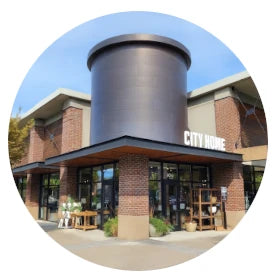Cane, Wicker, and Rattan Furniture: The Must-Know Difference
Wicker, a once staple of the late 1960s-early 70s, descended down the design ladder as the years progressed.
Picture it now and you might envision chairs, wide back and painted white. Although that “camp” look is popular right now amongst the cottage core crowd, modern wicker has taken on a more sophisticated feel.
Cane has stepped up and become the front runner for wicker decor. With its fine weaving and durable stature, it's obvious why this technique has brought about the resurgence of wicker.
Cane
Cane is the outer part of the rattan tree, created by peeling the top layer off of the vine and wrapping it around a solid frame. It is most often seen inlaid in the backs of chairs or dresser doors.
Because if it's incredible durably, cane is an excellent candidate for binding purposes. It is generally woven into tight, webbed patterns, giving cane its sophisticated look.

How to style cane
Cane’s lovely organic textures and unique patterns fit well into any color scheme. And because of its airy appearance it complements other woods and materials instead of rivaling them.
When decorating in mid century modern, consider the Clarita Sideboard by Four Hands Furniture. Versatile with ample storage and adjustable shelving, the softer appearance of cane gives a casual vibe to the more sleek lines so commonly found in mcm.

Indulge in the unique with the June Sofa. This piece is a study in cane perfection, taking inspiration from the lines of Japanese Tatami. Utilize this sofa as a focal point, using its stunning silhouette to tie your room together. Pair it with warm leather chairs and contrasting woods.

Use cane’s organic elements to naturally release warm energy into a room. The simple lines of the Carmel Sideboard plays well with a more dramatic environment. Add greenery for a vibrant burst of color.

Because of it's durable material, cane is often used for backing chairs. It's graceful weaving gives an elevated feel to everyday items. Infuse vitality and elegance into your dining space with the Antonia Dining Chairs.

Rattan
Rattan is a tropical palm tree from Southeast Asia. Unlike the palm trees we are used to seeing that grow straight up and fan out, this palm grows like a tree but eventually bends back to the earth. It then snakes through the ground like vines. Growing up to 2 inches in diameter and as long as 500 feet, these vines are then cut in 13 feet increments. The dry sheathing is removed and the outer bark is harvested for caning.
One of the strongest, most durable woods available, rattan is ideal for chairs and outdoor furniture. It is most commonly stained, painted or sealed, adding extra dimension to baskets and decor.

So what is wicker?
Wicker refers to the method, not the material. It’s most commonly attributed to any type of woven furniture made with organic materials but also synthetic ones such as resin and vinyl.
Wicker items are made when slender branches are woven around wood or metal frames. While styles and weaves vary, the most popular are rattan and cane.
The word 'wicker' is Scandinavian in origin, stemming from the word ‘vika’ meaning ‘to bend’. However the actual technique of wicker traces back to Ancient Egypt. While it has been a staple throughout the centuries, the 1800s saw it become a mainstream material. In recent memory, its heyday was the late 1960s and early 70s.
Stop into any store today and you’ll find stunningly crafted pieces from furniture to decor made from cane and rattan, both classified under wicker.
Keep it looking good
It’s easy to keep cane and rattan looking pristine, which is one of the reasons it's great in any household. Cane is less porous than wood and naturally repels drips and spills.
A simple dusting with a damp cloth and a polish with clear furniture polish is enough to keep your wicker looking fresh. For any spills or stubborn dirt, mild soap and warm water will clean it up. Take care not to use too much water and dry it completely to prevent sagging.
When using rattan outdoors, apply a lacquer yearly to protect it from the elements.
Well taken care of cane and rattan generally last 10 to 15 years. However, that doesn’t mean you can’t snag an amazing vintage piece. There are still incredibly preserved pieces out there waiting for the right collector.
Sustainability
Rattan is an exceptionally sustainable wood. It grows very quickly, in only about 5-7 years. It requires little water and is almost always grown without pesticides. The process of harvesting and manufacturing is a very low tech operation. Because most of it is done by hand, it doesn’t require facilities that pollute the environment.
Who is rattan and cane good for?
An excellent choice for decor across the board, wicker holds its own in all design and lifestyle spaces.
Rattan’s expedient growing time makes it an accessible material, which in turn makes it a more affordable material. When seeking budget friendly furniture and decor, rattan and cane are a versatile choice.
Rattan particularly shines in family friendly areas and kids rooms. Lightweight for easy mobility but durable enough for an impromptu fort. And the holy grail: easy to clean!
Cane can be found in more high end furniture because it’s elegant weaving lends an air of sophistication. If you're looking for upscale, cane is an impeccable choice.







